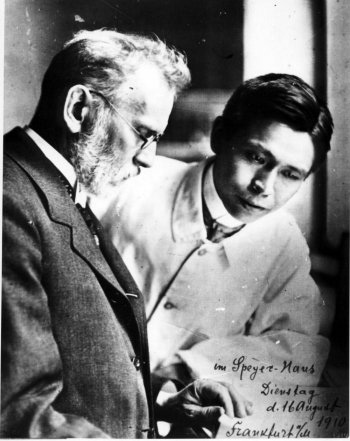|
Sahachiro Hata (1879-1938)

Sahachiro Hata was born on March 23, 1879
in Tsumo village, Mino District, Iwami Province (currently the western
part of Shimane Prefecture).
In 1897 Hata entered the Medical Department of the
Third Higher School
(the predecessor of the Okayama Prefectural Medical School, which later
became Okayama Medical University).
1897 he became assistant physician at the Okayama
Prefectural Hospital where he specialized in internal medicine under
Zenjiro Inoue and Hata also studied biochemistry from Torasaburo Araki.
He retained an interest in chemistry until the end of his life and when
he discovered Salvarsan in cooperation with Ehrlich years later, he
was aware that it was based on the instruction in chemistry he received
from Torasaburo Araki.
In 1907, the Japanese Government sent Hata to Germany. First he attended
the 14th International Congress for Hygiene and Demography in Berlin,
and read a paper entitled "Prevelance and prevention of the plague
in Japan" by Kitasato.
After the discussion, Hata left the podium and sat down about three
rows from the front. An old scholar sitting next to him spoke to Hata
intimately. According to Hata's reminiscences, the dialogue between
them was as follows:
"Doctor Hata! How many years have you studied about the plague?"
"I have studied it for about eight years."
"Hum. Were there any dangerous experiences in doing research on
the plague for such a long time?"
"Some danger may arise when we go to the actual site where the
plague is prevalent. However, laboratory work on the plague bacillus
is by no means dangerous. For a prison guard, it is not meritorious
to be attacked by a prisoner."
"It may be so, but…"
When the old man left the Congress room, someone
came and said to Hata "You are very fortunate to be spoken to by
Ehrlich in such a friendly manner, even though you only just came to
Germany." Then Hata knew that the old man was Ehrlich, and Ehrlich
recognized Hata's qualities. This lucky coincidence seems later to have
led Ehrlich to remember Hata and let him cooperate in the most important
stage of experimental chemotherapy.
Hata then studied at the Robert-Koch-Institute, Berlin, for a year under
August V. Wassermann. This was followed by three months of research
under M. Jacoby in the Moabit Hospital, Berlin. The results of this
work were published in seven papers.
In January 1909, Hata moved to the Staatliches Institut für Experimentelle
Therapie and the Georg-Speyer-Haus in Frankfurt am Main where he studied
under Paul Ehrlich.
Hata started to participate in this research at the stage where Ehrlich
had clarified the structure of atoxyl together with Alfred Bertheim,
had synthesized many derivates of organic arsenic compounds based on
this structure, and was testing the effects of each in animals infected
with spirochetes (First Sp. Recurrens then Sp. Gallinarum and finally
Sp. Pallidum).
After about three months, he obtained a general outlook for the work,
and he visited the University of Verona to get a strain of scrotal syphilis
of rabbits. He continued his experiments on this strain, which at last
resulted in the discovery of "606".
In September 1910, Hata returned home and thereafter he devoted all
of his efforts to publicizing the proper use of the new drug Salvarsan
and thorough treatment of syphilis using the drug properly.
Hata never stopped correspondence with Ehrlich while he was alive after
he passed away with his widow. Ehrlich's widow was very grateful to
Hata because of his great kindness during the time of material shortages
in Germany after the First World War.
From about 1928, Hata started to study a deep-acting disinfectant. After
performing experiments on about 40 synthetic quinoline compounds, Hata
continued to research on acridine derivates and discovered A21 (5-amino-2,8-dimethoxyl-N-methylacridinium
chloride). He also showed that Salvarsan was effective against rat bit
fever and other diseases. In 1928, he attended a committee for the testing
of Salvarsan at Frankfurt am Main sponsored by the League of Nations,
and played an important role in establishing international test standards.
Laboratory animal science in Japan was also initiated by Hata who noticed
that the test results of Salvarsan depended greatly on the strains of
mice used.
On November 22, 1938, Hata passed away in the hospital of the Medical
College of Keio-Gijuku- University at the age of 66. At his funeral
on November 25, about 2,000 persons paid their last respects to the
learning and virtue of Sahachiro Hata.
|
